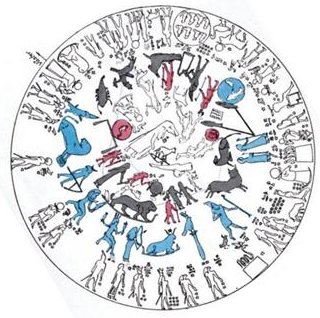|
When Polyphemus had
lost his single eye, bored through by the glowing hot olive stake
twirled around by Odysseus and those 6 of his chosen men who still
were alive (6 had been eaten), he intended to catch his tormentors: "There remained, however, the problem of getting out of the blocked cave. The Cyclops, groaning, groping with his hands, lifted away the stone from the door, and himself then sat at the entry. And Odysseus cleverly lashed together three large rams of the flock, 'well nurtured and thick of fleece, great and goodly, with wool as dark as violet'. And he prepared in all six triads of this kind. The middle ram of each set was to carry a man clinging beneath, while the side pair were to give protection. And as for himself, he laid hold of a goodly young ram, far the best of all, and curled beneath his shaggy belly; and as soon as early dawn shone forth, the nineteen rams, together with the flock, issued from the cave, bearing seven men ..." (Campbell 3) The Ram arrives after Pisces, but at the time of Homeros the Ram was at spring equinox (i.e. the 3rd sign from winter solstice), and the escape was significantly timed to early dawn:
The numbers, though, suggest a location halfway through the cycle: 6 out of 12 men (or 13 including Odysseus) had disappeared down into the mouth of Polyphemus. The number of rams instrumental for helping the company to emerge from the cave were 3 * 6 = 18, and 'one more'. Underneath these rams his men were clinging, in the center of each triad, while Odysseus himself was beneath the belly of the best of the beasts. 7 men out of 13 survived. Maybe the Q text describes events in the age of the Ram. At any rate we must notice how there is a sign of lashing together into a unit what presumably represents time periods, which we ought to recognize from earlier (cfr at toki): ... He took resinous wood, split it and stuck the splinters in his hair. Then he lashed two boats together, covered them with planks, danced and sang on them, and so he came to the old man's house. He sang: 'O, I go and will fetch the fire.' The old man's daughter heard him singing, and said to her father: 'O, let the stranger come into the house; he sings and dances so beautifully.' The stag landed and drew near the door, singing and dancing, and at the same time sprang to the door and made as if he wanted to enter the house. Then the door snapped to, without however touching him. But while it was again opening, he sprang quickly into the house. Here he seated himself at the fire, as if he wanted to dry himself, and continued singing. At the same time he let his head bend forward over the fire, so that he became quite sooty, and at last the splinters in his hair took fire. Then he sprang out, ran off and brought the fire to the people ... In Qa5-37 two canoelike forms (tao) are, it seems, 'lashed together', and the time apparently is when Old Spring Sun is ending (just after his 'midnight'):
540 (as in Qa5-40) - 240 (as in *Qa2-40) = 300. And once again the time is early dawn. The calendars for the night and for the daytime (Qa5-40) are here interwoven with the change from spring to autumn, and the new 'day' corresponds to the season of Moon. 5 * 40 = 200 and equal to half 400 (= 20 * 20). It is not a 'midnight henua' in Qa5-34, not as in Tahua where the single tao glyph tells us spring lies ahead:
|








